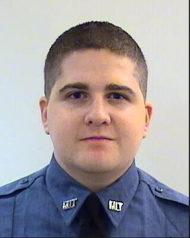Apr. 30, 2013 ? NASA's Cassini spacecraft has provided scientists the first close-up, visible-light views of a behemoth hurricane swirling around Saturn's north pole.
In high-resolution pictures and video, scientists see the hurricane's eye is about 1,250 miles (2,000 kilometers) wide, 20 times larger than the average hurricane eye on Earth. Thin, bright clouds at the outer edge of the hurricane are traveling 330 mph(150 meters per second). The hurricane swirls inside a large, mysterious, six-sided weather pattern known as the hexagon.
"We did a double take when we saw this vortex because it looks so much like a hurricane on Earth," said Andrew Ingersoll, a Cassini imaging team member at the California Institute of Technology in Pasadena. "But there it is at Saturn, on a much larger scale, and it is somehow getting by on the small amounts of water vapor in Saturn's hydrogen atmosphere."
Scientists will be studying the hurricane to gain insight into hurricanes on Earth, which feed off warm ocean water. Although there is no body of water close to these clouds high in Saturn's atmosphere, learning how these Saturnian storms use water vapor could tell scientists more about how terrestrial hurricanes are generated and sustained.
Both a terrestrial hurricane and Saturn's north polar vortex have a central eye with no clouds or very low clouds. Other similar features include high clouds forming an eye wall, other high clouds spiraling around the eye, and a counter-clockwise spin in the northern hemisphere.
A major difference between the hurricanes is that the one on Saturn is much bigger than its counterparts on Earth and spins surprisingly fast. At Saturn, the wind in the eye wall blows more than four times faster than hurricane-force winds on Earth. Unlike terrestrial hurricanes, which tend to move, the Saturnian hurricane is locked onto the planet's north pole. On Earth, hurricanes tend to drift northward because of the forces acting on the fast swirls of wind as the planet rotates. The one on Saturn does not drift and is already as far north as it can be.
"The polar hurricane has nowhere else to go, and that's likely why it's stuck at the pole," said Kunio Sayanagi, a Cassini imaging team associate at Hampton University in Hampton, Va.
Scientists believe the massive storm has been churning for years. When Cassini arrived in the Saturn system in 2004, Saturn's north pole was dark because the planet was in the middle of its north polar winter. During that time, the Cassini spacecraft's composite infrared spectrometer and visual and infrared mapping spectrometer detected a great vortex, but a visible-light view had to wait for the passing of the equinox in August 2009. Only then did sunlight begin flooding Saturn's northern hemisphere. The view required a change in the angle of Cassini's orbits around Saturn so the spacecraft could see the poles.
"Such a stunning and mesmerizing view of the hurricane-like storm at the north pole is only possible because Cassini is on a sportier course, with orbits tilted to loop the spacecraft above and below Saturn's equatorial plane," said Scott Edgington, Cassini deputy project scientist at NASA's Jet Propulsion Laboratory in Pasadena, Calif. "You cannot see the polar regions very well from an equatorial orbit. Observing the planet from different vantage points reveals more about the cloud layers that cover the entirety of the planet."
Cassini changes its orbital inclination for such an observing campaign only once every few years. Because the spacecraft uses flybys of Saturn's moon Titan to change the angle of its orbit, the inclined trajectories require attentive oversight from navigators. The path requires careful planning years in advance and sticking very precisely to the planned itinerary to ensure enough propellant is available for the spacecraft to reach future planned orbits and encounters.
The Cassini-Huygens mission is a cooperative project of NASA, the European Space Agency and the Italian Space Agency. JPL, a division of the California Institute of Technology, Pasadena, manages the Cassini-Huygens mission for NASA's Science Mission Directorate in Washington. The Cassini orbiter and its two onboard cameras were designed, developed and assembled at JPL. The imaging team consists of scientists from the United States, the United Kingdom, France and Germany. The imaging operations center is based at the Space Science Institute in Boulder, Colo.
Images and two versions of a movie of the hurricane can be viewed online at: http://go.nasa.gov/17tmHzo .
For more information about Cassini and its mission, visit: http://www.nasa.gov/cassini and http://saturn.jpl.nasa.gov .
Share this story on Facebook, Twitter, and Google:
Other social bookmarking and sharing tools:
Story Source:
The above story is reprinted from materials provided by NASA/Jet Propulsion Laboratory.
Note: Materials may be edited for content and length. For further information, please contact the source cited above.
Note: If no author is given, the source is cited instead.
Disclaimer: Views expressed in this article do not necessarily reflect those of ScienceDaily or its staff.
Source: http://feeds.sciencedaily.com/~r/sciencedaily/~3/3j6Oc6UrQls/130430101417.htm
nfl mvp lana del rey snl performance nick diaz sheryl sandberg superbowl recipes super bowl kick off chili recipes

 Carson Britt and Matthew Drake convinced everyone with their onstage demo of Laser Mountain at the Disrupt NY Hackathon. They attached Android phones to the Nerf guns (that TechCrunch gave away yesterday) to recreate a laser tag game with a real-time score server. After receiving the Nerf guns, they started working right away on Laser Mountain. “We already had the domain name lasermoutain.com, so we didn’t have a choice,” Britt said. When asked why they bought this domain, Drake answered, “I pick up domains all the time.” The Android phones track movements using the built-in gyroscopes and then transmit the information to a Node.js server. To register when someone is firing, they use the phone’s microphones and the Nerf gun’s loud firing noise. Last night, the team of two didn’t sleep at all to finish their hack on time for the onstage demo. It wasn’t their first hackathon but it was the first time at the Disrupt Hackathon. But it’s not the end for Laser Mountain. “We are going to Kickstarter it,” Drake said. With fewer than 24 hours of development, the team is certainly talented enough to succeed. You should watch the two developers play laser tag onstage:
Carson Britt and Matthew Drake convinced everyone with their onstage demo of Laser Mountain at the Disrupt NY Hackathon. They attached Android phones to the Nerf guns (that TechCrunch gave away yesterday) to recreate a laser tag game with a real-time score server. After receiving the Nerf guns, they started working right away on Laser Mountain. “We already had the domain name lasermoutain.com, so we didn’t have a choice,” Britt said. When asked why they bought this domain, Drake answered, “I pick up domains all the time.” The Android phones track movements using the built-in gyroscopes and then transmit the information to a Node.js server. To register when someone is firing, they use the phone’s microphones and the Nerf gun’s loud firing noise. Last night, the team of two didn’t sleep at all to finish their hack on time for the onstage demo. It wasn’t their first hackathon but it was the first time at the Disrupt Hackathon. But it’s not the end for Laser Mountain. “We are going to Kickstarter it,” Drake said. With fewer than 24 hours of development, the team is certainly talented enough to succeed. You should watch the two developers play laser tag onstage:









 Google 1, Germany 0. German regulators were furious when it was found that Google’s street car was unintentionally collecting email, photos, and passwords from its citizens’ unprotected Wi-Fi networks — something Hamburg-based regulator, Johannes Caspar,?called “one of the biggest data-protection rules violations known.” Yet, regulators could only muster a financial hand slap of 145 euros, or about 0.005 percent of the search giant’s annual profits. Regulators couldn’t find any “criminal” violations for the data-stealing misstep, and German law has a maximum ceiling of 150K euros for privacy law negligence, according to Bloomberg. Between 2008-2010, Google’s street car, which?photographs?and maps cities with a 360 degree camera, had ?stolen valuable, yet unencrypted data. Google chief privacy counsel, Peter Fleischer, claims it was?unaware?of the breach and did not use the sensitive information. Of course, not everyone in the Eastern Hemisphere has privacy hangups, like this randy Australian couple who cheerfully waved at the Google street car while having (fake?) sex. Google has been on a legal hot streak; it avoided potentially tens of millions of dollars in fines from the U.S. Federal Trade Commission for antitrust accusations related to how it prioritizes its own products in search results. Politico’s Tony Romm has a thorough account of how Google hired government insiders to deftly navigate the federal investigation. Google would have had a legal hat trick, were it not for a sizable $22.5 million settlement in 2012 for secretly collecting data from Apple’s Safari Internet browser. Google is still embroiled with six European nations over its general privacy policies, so Europe may still get the lucrative fines it’s desperately seeking. [Image Credit: Google]
Google 1, Germany 0. German regulators were furious when it was found that Google’s street car was unintentionally collecting email, photos, and passwords from its citizens’ unprotected Wi-Fi networks — something Hamburg-based regulator, Johannes Caspar,?called “one of the biggest data-protection rules violations known.” Yet, regulators could only muster a financial hand slap of 145 euros, or about 0.005 percent of the search giant’s annual profits. Regulators couldn’t find any “criminal” violations for the data-stealing misstep, and German law has a maximum ceiling of 150K euros for privacy law negligence, according to Bloomberg. Between 2008-2010, Google’s street car, which?photographs?and maps cities with a 360 degree camera, had ?stolen valuable, yet unencrypted data. Google chief privacy counsel, Peter Fleischer, claims it was?unaware?of the breach and did not use the sensitive information. Of course, not everyone in the Eastern Hemisphere has privacy hangups, like this randy Australian couple who cheerfully waved at the Google street car while having (fake?) sex. Google has been on a legal hot streak; it avoided potentially tens of millions of dollars in fines from the U.S. Federal Trade Commission for antitrust accusations related to how it prioritizes its own products in search results. Politico’s Tony Romm has a thorough account of how Google hired government insiders to deftly navigate the federal investigation. Google would have had a legal hat trick, were it not for a sizable $22.5 million settlement in 2012 for secretly collecting data from Apple’s Safari Internet browser. Google is still embroiled with six European nations over its general privacy policies, so Europe may still get the lucrative fines it’s desperately seeking. [Image Credit: Google]




